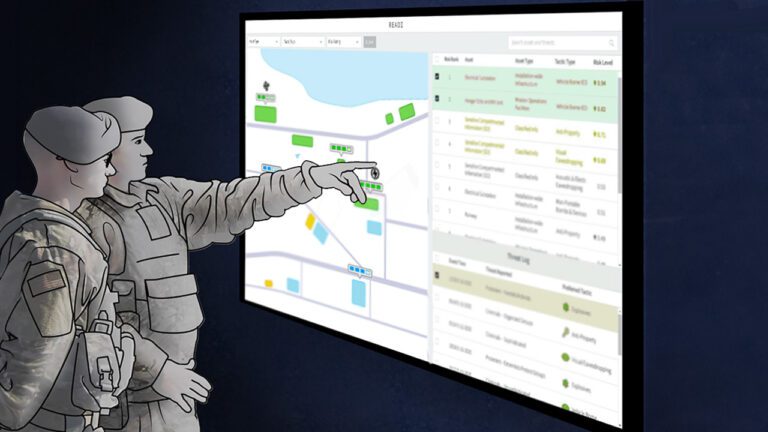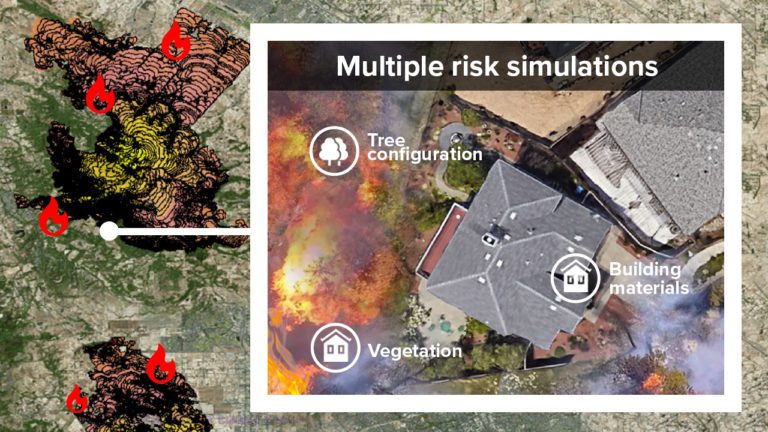Scruff™
A framework for building
artificial intelligence systems
A framework for building artificial intelligence systems
Making AI easier
Most modeling languages assume that only one kind of component–either constraint systems or probabilistic methods–describes an entire landscape.
AI reflects the real world, which is not always neatly described. Because there’s no one-size-fits-all solution for everything that an AI system needs to do, we need to use appropriate techniques for different aspects of the system. Depending on uses, model components such as those for perception, inference, learning, and planning can be mixed and matched.
These piecemeal components need to be organized coherently in an overarching modeling framework. This compositional framework is what Scruff™ from Charles River Analytics delivers.
“Scruff allows you to integrate many different kinds of model components—physics, probabilistic, and neural networks—within a single model.”

Dr. Avi Pfeffer
Chief Scientist at Charles River Analytics and inventor of Scruff
AI development
challenges
Without Scruff, AI development runs into problems.
It’s either:
- Neat without being able to accommodate many different kinds of models
- Scruffy by accommodating all models but in a way that is not easily explainable
The benefitof Scruff
Open-source Scruff allows you to:
- Build explainable AI models that can be experimented with
- Create a coherent framework so you can easily find and interchange components
- Democratize the creation of AI
- Enhance capabilities in developing AI systems, particularly systems that make decisions in the face of uncertainty
The role of probabilistic programming
A probabilistic model is one with a set of variables, where each variable has its own definition and tendencies. Each variable is defined in terms of other variables to make a network.
Probabilistic programming takes complex probabilistic models and makes them simple, expressible, and controllable. Such probabilistic programming is one of the key foundations of Scruff; it can easily describe a number of physical phenomena and allows developers to quickly create probabilistic models. Probabilistic programming unifies all representations in a single framework and makes them more understandable.
Scruff applies the same principle to other kinds of AI components, so users don’t need a special-purpose model to model any given combination of components. The general framework does the job efficiently and users can slot the components in as they need them.

Key features of Scruff
Predictive processing is reasoning about dynamic systems by predicting what to expect and then reconciling the errors.
Scruff allows users to represent hierarchical dynamic models in which each layer of the model predicts the layer below and then processes errors to the layer above. The models have many layers of abstraction, with a chain of predictions down the hierarchy and a chain of error processing up the hierarchy.
Scruff also allows the flexible instantiation of variables at different time points. Users do not have to model everything in lockstep at the same discrete time step. Instead, users can instantiate variables whenever they need to. In predictive processing, higher-level variables in the hierarchy will tend to evolve more slowly and lower-level variables will tend to do so more quickly.
Implicit representation means that every model component is interpreted as a generative probabilistic model, even if it is not one. Under this approach we stipulate that the components support various operations that relate to each other in the same way they would if actually using a generative probabilistic model.
The principles work for all kinds of models. For example, a physics space model that uses differential equations can be interpreted as probabilistic by looking at the propagation of the differential equations. Given the final state, we can perform back inference of the initial state through these differential equations. A data-driven model like a neural network is yet another example, where we need to be able to take an output and get a probability distribution of the inputs. Constraint models with hard and soft constraints can also conform to this methodology.
Such an approach corrals all models under one umbrella and breaks down components into more readily manipulated units with predictable behaviors.
Every model component using implicit representation is represented as a stochastic function, which means that it takes inputs and probabilistically or stochastically generates an output. The approach is based on principles derived from probabilistic programming, where you describe basic functions and use them to build more complex models.
Stochastic functions just describe model components. Variables actually associate these model components with things in the real world, especially ones that vary over time and space. An instantiation is a particular instance of the variable at a particular point in time and space. A number of these instantiations can be used to fully describe a situation.
The advantage of such flexibility, especially compared with fixed time interval models, is that you can base your instantiation of variables only when you access evidence. Since different variables evolve at different rates, the instantiation can be made granular: You can instantiate frequently changing variables frequently and slowly changing variables more rarely.

Scruff in action
Scruff is a powerful building block for Charles River’s leading-edge work in crafting complex AI systems. Many of our signature AI initiatives involve integrated systems made up of multiple components. To be truly versatile, they require the overarching framework that Scruff provides.

OPEN
An AI-driven system forecasting critical mineral supply, demand, and global trends
KAML
Real-time combat logistics platform estimating ammunition consumption and resupply needs
READI
A risk-assessment tool for installation security decision-making
HIEROPHANT
A tool integrating hierarchical protocols with command-and-control of uncrewed systems
PRESCRIBE
A tool to assess mental health through preconscious responses
POWERED
An application that uses probabilistic modeling to determine the reliability of power supplies
WIMPLE
A wildfire risk assessment and mitigation solution for homeowners and communities
PERCEPTS
A tool to enable more robust AI model development
PSI-Coach
Combining probabilistic programming with cognitive models to predict human behaviors
STAPLES
Using probabilistic programming to enhance supply chain and logistics operationsAdvancing the field of probabilistic programming
Charles River Analytics is a pioneer in the field of probabilistic programming. Chief Scientist Dr. Avi Pfeffer developed the first general purpose probabilistic programming language in 2001; since then, he has developed another probabilistic programming language, Figaro™, published numerous papers, presented at invited talks, and authored a textbook, Practical Probabilistic Programming.
We introduce Scruff, a new framework for developing AI systems using probabilistic programming. Scruff enables a variety of representations to be included, such as code with stochastic choices, neural networks, differential equations, and constraint systems. These representations are defined implicitly using a set of standardized operations that can be performed on them.
The theory of predictive processing encompasses several elements that make it attractive as the underlying computational approach for a cognitive architecture. We introduce a new cognitive architecture, Scruff, capable of implementing predictive processing models by incorporating key properties of neural networks into the Bayesian probabilistic programming framework.
In this invited keynote, Dr. Avi Pfeffer describes the unique capabilities of probabilistic programming languages (PPLs) and the development of two PPLs at Charles River: Figaro and Scruff.
Our People

Dr. Avi Pfeffer
Chief Scientist
Dr. Avi Pfeffer,
Chief Scientist
Dr. Pfeffer leads Charles River’s research in a variety of computational intelligence techniques, such as probabilistic reasoning, machine learning, and computational game theory. He developed the first general-purpose probabilistic programming language IBAL; Figaro™, Charles River’s probabilistic programming language, and Scruff™. Avi has produced systems for representing, reasoning about, and learning the beliefs, preferences, and decision-making strategies of people in strategic situations. He also invented object-oriented Bayesian networks and probabilistic relational models, which form the foundation for the field of statistical relational learning. Dr. Pfeffer serves as Action Editor of the Journal of Machine Learning Research and served as Associate Editor of Artificial Intelligence Journal and as Program Chair of the Conference on Uncertainty in Artificial Intelligence. He received his Ph.D. in computer science from Stanford University and his B.A. in computer science from University of California, Berkeley.

Dr. Sanja Cvijic
Senior Scientist
Dr. Sanja Cvijic,
Senior Scientist
Dr. Cvijic received a Ph.D. in Electrical and Computer Engineering from Carnegie Mellon University, with a focus on applying deterministic optimization methods to power systems. At Charles River, she applies probabilistic relational models and other theoretical tools to design probabilistic reasoning systems for real-world problems. Projects range from ambitious satellite investigations to more familiar topics, like modeling the health and lifetime of power transformers. Prior to joining Charles River Analytics, she worked at a consulting/engineering start-up company as the Director of Software. She managed a variety of projects as the Principal Investigator, wrote SBIR proposals, led software development, and performed modeling, optimization, and simulation studies applied to large-scale power grids. She has also managed a SBIR NASA-funded project on the development of a dynamic simulator of a turbo-electric distributed propulsion aircraft.

